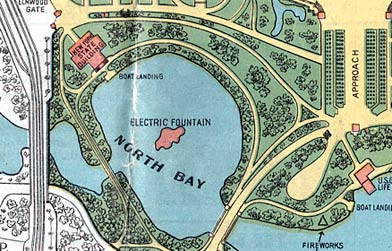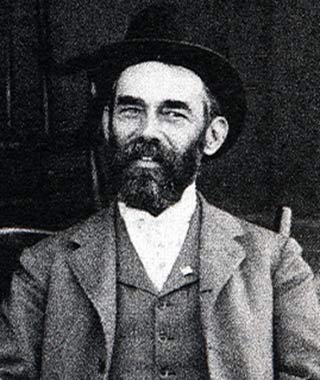

|
| Park Lake: Electric Fountain |
 |
|
The Pan-American Exposition featured the most advanced electrically powered and lighted fountains yet seen in expositions. The Buffalo fountains were designed by Luther Stieringer, a national pioneer in lighting design whose visionary approach was most famously realized in exposition lighting. One feature which Mr. Stieringer favored greatly would not be installed in the Court of Fountains in the center of the Exposition grounds but in the bucolic setting of the North Bay of the Park Lake (now Hoyt Lake). It was called a "show," to differentiate it from the other Exposition fountain displays. In February, 1901, the Park Commissioners gave permission for a fountain to be temporarily installed in the North Bay of the Park Lake. Parks superintendent John C. Graves said, "Some time ago the board contemplated putting into the bay a fountain of this sort, with alternating electric lights of different colors," but the project was dropped. He added, "It would be a nice thing if the Exposition people would put in a permanent fountain, but I don't think they will." The superintendent was correct. Exposition chief of the Mechanical and Electrical department, Henry Rustin, supervised construction of an artificial island of rocks in the center of the North Bay, 160 feet long by 380 feet wide, rising 10 feet above the water line in what one writer called a 'lizard-shape.' No wires or pipes were visible to observers. |
 Luther Stieringer |
|
Electrical current was generated in a small building on the lake shore. Unseen was a compartment built into the island that contained two water pumps provided by P.H. and F.M. Roots Co. of Connersville, Indiana; also two electric motors from E.G. Barnard of Troy, N.Y. Within the compartment were twenty-two searchlights and control center with room for an operator. The fountain was designed to be operated only during short periods of the evening, providing a colorful light show for less than 30 minutes. It featured nine different piping systems controlled by levers and a grand geyser in the center that could throw a 1.5" stream 250 feet high. The 102 possible fountain effects included wheat sheaves, ring curtains, calla lilies, pulverizers, fan jets, and mist banks. The searchlights were designed to project light up into the fountain sprays through disks with color screens. The Buffalo Express wrote, "an operator inside will regulate the force of the water and the color of the lights which are to be played upon it. Every detail will be so completely under the control of the man that he will be able to get the desired effects of light and form just as a pianist, by operating the keys, is able to produce different musical expressions." The fountain opened June 26, having been delayed by various issues. A press dispatch said, "Color, electricity, and hydraulics have lent their best to the display. It is called the 'circus' feature of the exposition and it has all that that word implies of the grandeur and magnificence and dazzling spectacle. The water pouring from the jets assumes fantastic forms, conventionalized to some extent, but natural in the exfoliate quality of jaggedness. These are subject to an evermoving kaleidoscopic play of green, blue, red and white light, causing the water drops to resemble in turn showers of sapphires, turquoises, rubies and diamonds." By September 1, it was operating from 6:30 - 9:00 p.m. nightly. The designer complained later that the maximum time it should have operated was 12- 15 minutes to preserve the spectacle. And he suggested that it should have been more thorougly rehearsed beforehand. His comments went unrecorded during the Exposition as thousands of people gathered each evening to watch the fountain play in the middle of the North Bay. They lined the wooded shore of the lake or took the rides on gondolas or electric launches around the fountain for a closer view. Then they stayed for the nightly fireworks show. Note on the post-Exposition fate of the fountain: The Pan-American Exposition closed on November 1, 1901. The companies supplying the equipment for the electric fountation removed it, leaving the rock island. On November 27, the Park Board was informed that the exposition company had no funds to restore the park lands it had used, including the artificial island in the North Bay. It remained until the spring of 1902 when the Park Board asked for bids to remove it. A city alderman asked for a hold on that demolition to pursue private funding for purchase of machinery to make the fountain operational. This idea went the way of the others that including saving and moving the Electric Tower, the Temple of Music, even retaining the grounds as a theme park. No one in Buffalo had any money to invest in anything related to the Pan-American Exposition. The island was dismantled for a fee of several hundred dollars.
|
||